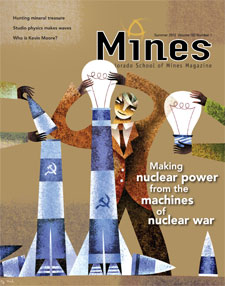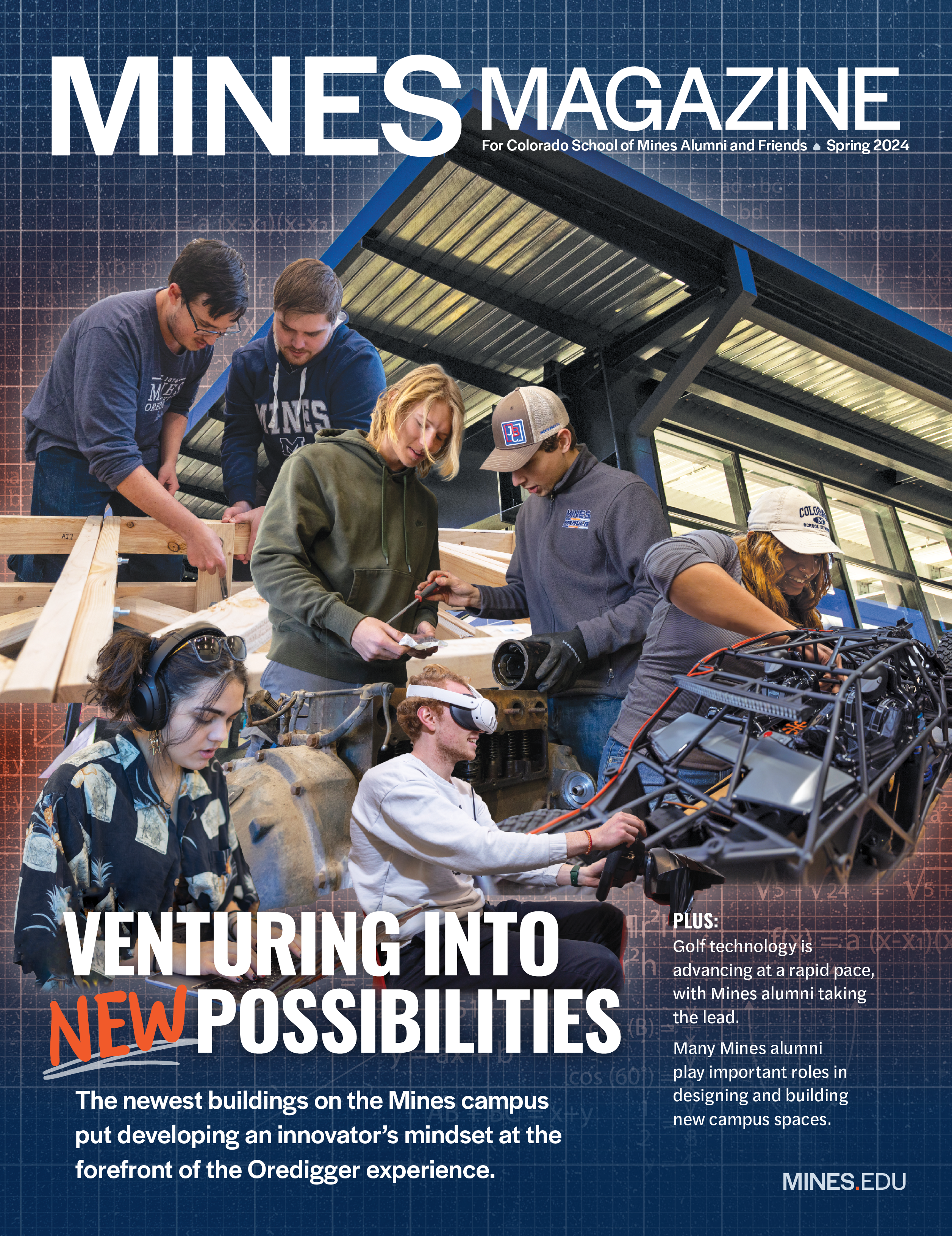A 20-year agreement signed in 1993 between the U.S. and Russia to turn 20,000 nuclear warheads into nuclear fuel contained some fatal flaws, but the deal was salvaged thanks in large part to the work of a team led by a Mines alumnus.
 Nuclear power provides about 20 percent of the electricity used in the United States. Since 1995, about half of that has been generated with uranium from dismantled Russian nuclear warheads, shipped to the U.S. under the Megatons to Megawatts (MTM) program. When the 20-year program wraps up in 2013, about 20,000 nuclear warheads will have been put out of commission.
Nuclear power provides about 20 percent of the electricity used in the United States. Since 1995, about half of that has been generated with uranium from dismantled Russian nuclear warheads, shipped to the U.S. under the Megatons to Megawatts (MTM) program. When the 20-year program wraps up in 2013, about 20,000 nuclear warheads will have been put out of commission.
The useful conversion of so much destructive power (think three warheads a day for 18 years) is an inspiring story, but the deal almost fell apart. Structurally flawed from the outset, the agreement required a decade-long collaborative effort led by private sector nuclear industry partners, with considerable support from the U.S. and Canadian governments.
This effort has not been well covered by the media. Even less has been reported about the role played by Jerry Grandey ’68, who sounded the alarm, helped devise the rescue strategy, rallied support, and for six years led tough negotiations with the Russians that finally corrected the flaws and ensured that the weapons continued to be dismantled.
Right Man, Right Place

�I have this innate belief in the ability of human beings to put aside hysteria,� says Jerry Grandy �68.
It’s uncanny how well prepared Grandey was to intervene when the need arose. He was already on a first-name basis with the Russian minister of atomic energy. As president of Uranium Producers of America, Grandey had recently sued Russia for dumping uranium on the world market, and then spent several months showing the minister and others how they could join the international uranium market on a legitimate basis.
He instantly understood the threat posed to the weakened uranium market by the program, and, as Cameco’s senior vice president for marketing and corporate development, he had a strong incentive to protect the market from collapse.
Based in Canada, which has never developed nuclear weapons and is a trusted leader in the international nonproliferation community, Cameco already had a history of working with Ottawa to resolve nuclear scuffles.
And along with the right connections, background and credentials, Grandey also happened to be in London when President Clinton announced the MTM program in February 1993, so he had only a short plane ride to Moscow.
Peculiarities of the Uranium Market
It’s hard to appreciate what follows without understanding a little about how nuclear fuel is bought and sold. It’s a market unlike any other.
After uranium ore is milled and refined, the concentration of the uranium 235 isotope is around 0.7 percent. To make nuclear fuel (low enriched uranium, or LEU) the concentration of this isotope must be increased to about 5 percent, while weapons-grade uranium (highly enriched uranium, or HEU) must be closer to 90 percent.
The cost of LEU is determined by two factors: the cost of the original refined concentrate required to make the fuel (the natural uranium component) and the cost of increasing the concentration of uranium 235 from its natural level to the required level of 5 percent (the enrichment component).
When a utility company pays for a delivery of LEU, it writes at least two checks: one to the company that supplied the natural uranium component (it takes about 8 pounds to make 1 pound of LEU) and another to the company that enriched it. The amount paid for uranium depends on the market. The cost of enrichment depends on the market price of the enrichment service and the amount of work required to achieve the desired levels of uranium 235.
Making nuclear fuel using HEU taken from Soviet warheads requires no new mining, refining or enriching since all of this was done to make the weapons material decades before. Instead, the HEU is mixed with the tailings left over from previous enrichment operations. The result of the blending is LEU suitable for use in U.S. and other light water reactors.
However, while making LEU from HEU is less costly, Russia entered into the MTM program expecting to be compensated in the conventional way for both the uranium component and the enrichment component.
“When Russia agreed to dismantle the 20,000 warheads, they weren’t trying to make the world a safer place, although that’s what everyone said. They desperately needed the hard currency and expected to get paid fair value for all of the components,” explains Grandey.
But the way the agreement was framed, this was unlikely to happen.
The Moscow Meeting
When he met with Russia’s minister of atomic energy in March 1993, Grandey’s suspicions about the details of the agreement were confirmed.
The impact the deal would have on demand for enrichment services in the U.S. market had been considered. The U.S. government owned the only two uranium enrichment facilities in the country, and since the anticipated LEU imports from Russia would supply the U.S. with about half of its needs for 20 years, one of the plants would close.
On the other hand, the agreement gave almost no consideration to the impact on the uranium market. “They just didn’t think about it,” says Grandey. But it was sure to be substantial. Russia was about to displace about 20 percent of world demand for LEU without requiring anything from uranium producers. “About 20 percent of world demand was about to evaporate,” says Grandey. With prices already low, the impact on the industry would be devastating. It could also scuttle the MTM program.
Grandey recalls his conversation with the minister of atomic energy: “I said, ‘Do you realize that this 20 million pounds equivalent that the weapons material represents is going to destroy the uranium market? The price of uranium will approach zero.’ The minister’s response was, ‘Well, if it does, then we won’t do the deal. We won’t dismantle the weapons.'”
Creating a Phantom Mine
Grandey’s first attempts to reach the U.S. State Department to explain the threat to the MTM program went nowhere. However, when the Canadian government initiated legal action under the U.S./Canada Free Trade Agreement, arguing Russia had been given an advantage in the U.S. uranium market, Grandey got his opportunity to explain the flaws in the program and how they could be fixed.
James Timbie, a senior adviser to the undersecretary for international security and nonproliferation at the U.S. State Department, was one of the first to understand why MTM was on a trajectory to crater the uranium market, and why that endangered the whole program. “The agreement had sounded very simple, but in fact it was very complicated,” he says. “We first learned all this from Jerry.”
Once Timbie and his colleagues understood the plan for making MTM work, they enlisted the support of Congress. “Legislation was passed that treated the LEU from Russia as if it were from a new mine coming into production,” explains Grandey. The uranium from this new ‘mine’ could only enter the U.S. under a quota system that began at 2 million pounds of natural uranium equivalent per year, and grow by 2 million pounds per year until it hit 20 million pounds.
The quota system was almost as ephemeral as the mine it governed. With 20,000 warheads to process, far more uranium needed to be moved than was permitted by the quota. Even in the first year of shipments, the natural uranium equivalent of the LEU actually exported by Russia to the U.S. exceeded the quota tenfold.
It was the method of compensation that kept Russia in compliance: For every pound of imported LEU that was in excess of the quota, the country received cash from the United States Enrichment Corporation (USEC) for the enrichment component and 8 pounds of natural uranium that was stored in specially monitored stockpiles for later sale.
The only reason Russia went along with this arrangement was because there was no quota for the enrichment component, which was more valuable. Even during the first year, it received hard currency for about 70 percent of the value of its LEU. For the rest, it had a large stockpile of natural uranium.
Growing Stockpile, Mounting Frustration
As the years passed and the stockpile of uranium grew, the pressure to find a buyer increased. “They were getting paid for the enrichment, but the natural uranium was just piling up,” Grandey explains. “We all knew something would have to be done, but it wasn’t clear what that would be.”
Between 1994 and 1999, Grandey and others met every two or three months with a team of Russians to discuss the uranium component. “The negotiations were not easy,” he recalls. “The Russians kept trying to introduce an agent into the process, someone to skim money off for the benefit of people within Russia, and we kept excluding the agent. Many times we ended up simply saying, ‘If you insist on that, we’re leaving’ and we’d get up and fly home.”
In 1997, with tensions escalating, Grandey formed a partnership between Cameco, the French nuclear energy company Areva, and its German counterpart, Nukem. With better access to the European market, they stepped up purchases of uranium, but even this alliance of nuclear energy industry giants couldn’t put much of a dent in the tottering Russian stockpile of almost 30 million pounds.
Appropriating a Solution
In 1998, mounting Russian hostility and the privatization of USEC set an initiative in motion that ended up solving the problems in the uranium market.
To break the stalemate, Russia and the U.S. needed a private buyer for the natural uranium component. However, after a decade of low prices had weakened the industry, the Cameco-Areva-Nukem partnership was the only serious contender for the role. But buying the entire stockpile was too risky the partnership, and so was committing to the purchase of future shipments, while the accumulated uranium could still bury the market.
The breakthrough came when Senator Pete Domenici successfully rallied support for a Congressional appropriation of $325 million to buy the Russian uranium and keep it off the market for 10 years. The purchase would be contingent upon Russia signing a commercial agreement for the sale of the natural uranium component of future LEU shipments through the end of the program. It was the breakthrough they needed, and Grandey signed an agreement on behalf of the three companies.
Around the same time, another stockpile of natural uranium owned by USEC surfaced, which was purchased by the Department of Energy and added to the sequestered stockpile. Russia was required to create a similar sequestered stockpile. Cameco and Areva also delayed projects to keep from adding to the global uranium supply.
“All this was done to boost the price of uranium and make the deal work,” says Grandey. “Our thinking was that if we can keep the price of uranium around $10-$14 per pound, we can continue to operate our mines, the Russians will get what they need, and we’ll be able to make the deal work. And that’s pretty much what happened. After 1999, Russian threats of tearing up the agreement evaporated.”
Looking back, Grandey is proud of the efficiencies achieved by the public-private collaboration. “The brilliance on the part of the U.S. and Canadian governments was to turn the implementation of the deal over to the private sector. We amended it about eight times, and each time we had to get approval from the Russian and U.S. governments, but that was easy because we were making the nonproliferation deal work.”
The State Department is equally positive. “They were our partners in implementing the agreement, which has now supplied roughly half of the enriched uranium to the United States for almost 20 years,” says Timbie. “Problems arose from time to time, and whenever they did, we’d get together with Jerry and solutions would be found.”
Beyond Nuclear
In 2003, 10 years after joining the company, Grandey was appointed CEO of Cameco, remaining in the position until June 30, 2011. Despite careful succession planning, his exit was tumultuous, coming three months after the Fukushima Daiichi nuclear meltdown. “I’ve dealt with a lot of crises in my career, so it was somehow fitting to go out handling one more,” reflects Grandey.
In May 2012, Grandey was invited to Oslo, Norway, after a worldwide search identified him as one of about 90 nominees for the 2012 Business for Peace Awards. Although Grandey was not among the final six honorees, the recognition of his role in MTM is a great honor, which he is quick to share with others. The success of the program has required the support of numerous legislators, government officials and, in particular, USEC, says Grandey. “They have been absolutely instrumental in the performance of this deal as well.”
While retirement has brought big changes for Grandey, some routines remain the same. A former member of the Mines swim team, he still begins most days with a 4,000-yard workout. His father, now in his mid-90s, still regularly beats him at golf. And along with continued philanthropic involvement in the Saskatoon community, he serves on the Dean�s Advisory Council of the University of Saskatchewan’s Edwards School of Business, and on the Board of Governors of the Colorado School of Mines Foundation. Preferring to make a clean break, he’s not on Cameco’s board anymore, but he is on the boards of four other companies.
In spite of the post-Fukushima slowdown, his outlook for the nuclear energy industry is positive. “I have this innate belief in the ability of human beings to put aside hysteria,” he said in an interview for the Canadian newspaper, The Globe and Mail. “Once people reflect on the risks associated with other energy sources, they’ll come to the rational conclusion that nuclear, even in the worst circumstances, is still better than the alternatives.”
That’s not what he believed when he began his career. After earning his degree in geophysics from Mines in 1968 and completing his service with the Army Corps of Engineers in Korea, he studied law at Northwestern. While a student, he worked for a public interest law firm, where he was assigned to challenging the licensing of nuclear plants around the Great Lakes. It remains one of the great ironies of his career. “I spent two and a half years opposing the interests of companies that ultimately became my best customers,” chuckles Grandey.



